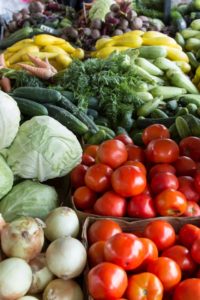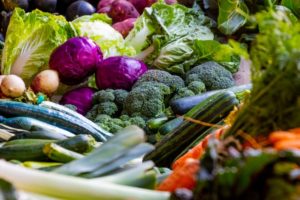 Is it true that the combination of apples, tomatoes and legumes can replace the role of cholesterol medicine within high cholesterol patients? How about the combination of citrus fruits, bananas and leafy green vegetables as a substitute for high blood pressure medicine? Or the combination of black tea, vitamin D (from the sun) and leafy green vegetables as a substitute for metformin – a type of medicine for diabetes?
Is it true that the combination of apples, tomatoes and legumes can replace the role of cholesterol medicine within high cholesterol patients? How about the combination of citrus fruits, bananas and leafy green vegetables as a substitute for high blood pressure medicine? Or the combination of black tea, vitamin D (from the sun) and leafy green vegetables as a substitute for metformin – a type of medicine for diabetes?
Before that, let’s firstly state information which is proven true. Fruits and vegetables are important for a healthy and balanced diet. There is no single fruit or vegetable which will provide all nutrients and nourishment needed by our bodies. Hence, as cliché as this statement sounds, we are recommended to vary our intake of fruits and vegetables.
Let’s see several studies which was on the role of fruits and vegetables as replacement for prescribed medicine.
Heart disease
In a research pertaining to the relationship between diet and health which involved 110,000 men and women for 14 years has found that the risk of getting a heart attack reduce as much as 30% for those who take at least 8 servings of fruit and vegetables a day compared to those who only take 1.5 servings a day.
Researchers has found that leafy green vegetables (spinach, broccoli, cabbage etc) and citrus fruits are the main contributors in reducing the risk of heart attacks.
This research is agreed upon and validated by other major research in Europe.
High blood pressure
A research by Appel and associates studied how the role of food which has four main elements – fruits, vegetables, low fat dairy and food containing low saturated fats – influences the blood pressure of a high blood pressure patient. It is found that those who practice the aforementioned diet, on average, successfully reduced the systolic blood pressure by 11mmHg and diastolic by 6mmHg. The effect of the aforementioned food combination is said to be similar to the effects of high blood pressure medication.
In another study named OmniHeart showed that food additions, which contain unsaturated fats and protein to a diet high in vegetables and fruits, has successfully further reduced the blood pressure in high blood pressure patients.
A meta-analysis in 2014 by Yokohama and associates supports the correlation between the reduction of high blood pressure and a vegetable dense diet.
Cancer
 How about cancer? A few initial research showed that a diet containing fruits and vegetables protected someone from cancer. However, a lot of those research has individual limits due to the selected research design. Of late, the more complete research design – using cohort studies – is unable to confirm the role of a diet loaded with fruits and vegetables as a weapon to avoid cancer.
How about cancer? A few initial research showed that a diet containing fruits and vegetables protected someone from cancer. However, a lot of those research has individual limits due to the selected research design. Of late, the more complete research design – using cohort studies – is unable to confirm the role of a diet loaded with fruits and vegetables as a weapon to avoid cancer.
The Nurses’s Health Study and Health Professionals’ Follow-up Study conducted by researchers from Harvard University found that the risk of getting cancer is the same among those who eat a lot of fruits and vegetables and those who eat a little.
The report from the World Cancer Research Fund, however, suggests that vegetables with a low starch content (leafy green vegetables, cabbage, garlic etc) may have protective properties from mouth, throat, digestive tract and stomach cancer.
In another research, it is suggested that lycopene in tomatoes reduces the risk of getting prostate, lungs and mouth cancer. However, this finding is quite weak when replicated in a few other different populations. This suggests that the formation of cancer is influenced by various causes and factors such as pollution as an example of environmental factor.
What is certain, evidence of food pattern high in red meat, especially processed meat increases risk in several types of cancers is strong and consistent. IARC or the International Agency for Research on Cancer has classified read meat to be “potentially carcinogenic” and processed meat to be “carcinogenic”.
Diabetes
So far, research pertaining to fruits and vegetables in relation to diabetes is quite limited. However, there are several early research findings which provides interesting evidences to be shared.
One of it is from the Nurses’s Health Study and Health Professionals’ Follow-up Study. This study’s finding is that those who practice eating raw fruit (not blended or pressed for juice) has lower risk of getting diabetes.
More interestingly, it was found that those who frequently practice drinking fruit juices has an increased risk of getting diabetes. Researchers noted that changes in fruit nutritional value through pressing processes may have contributed to this increased risk. Further studies are needed to confirm this.
In another study which involved over two thousand Finnish men, it was found that a diet pattern which is high in fruits and vegetables reduced the risk of getting diabetes.
Digestive tract – Gastrointestinal tract
From young, we are constantly reminded by our parents on the importance of eating vegetables and fruits to ease bowel movements. Same goes for women after childbirth who are constantly reminded to eat fruits and vegetables in addition to drinking lots of water in their daily diet.
Fruits and vegetables contain fibre. There are two types of fibre which is soluble and insoluble. Vegetables, fruits and grains are good sources of soluble fibre. This type of fibre will absorb water in the intestines and will consequently produce soft and loose stools. High fibre will stimulate bowel movements and ease in expelling waste from the body. The effect is, carcinogenic substances will not populate the intestine long enough to react with the intestinal cells.
Fibrous food such as vegetables and fruits can prevent someone from getting diverticulosis – which is an inflammation of pouches abnormally formed in the colon. These pouches – which is diverticulosis- are formed from the high pressure pushes against weak spots in the colon walls. One of the causes of high pressure is from low fibre intake.
Ocular health
The findings from several research suggests that those who practice having fruits and vegetables in their diet can reduce two types of ocular disease due to aging which is cataract[5]and macular degeneration[6].
Lutein and zeaxanthin, two nutrients which is in green vegetables can prohibit someone from cataract. In a study which involved 35,000 participants, it was found that the risk of getting cataract is low for those who take lutein and zeaxanthin in sufficient quantities.
Conclusion
Members in the field of medicine are continuously looking for the best treatment for patients, based on latest research. Allegations and demands which are extraordinary or does not make sense will not be a basis to treat patients.
Malaysia is a tropical country which is rich is a variety of vegetables and fruits. We should be thankful for this blessing. It is very important that we include vegetables and fruits to our daily food intake.
So far, we are encouraged to eat a variety of vegetables and fruits in various colors and textures to get good results for our health as mentioned above.
There is no certainty or proof of research that specifies certain fruits or vegetables, if eaten, will act as a medicine given by the doctor. Eat your medicine, at the same time change your diet and exercise which is God willing, effective.
Dr Helmy Hazmi is a community medicine specialist with a specialization in Epidemiology and Biostatics. Now, he is serving in his hometown of Kuching, as a medical lecturer. Get to know more about him on The Team page. This article has been translated by Suzanna Zainal Abidin.
Reference:
- Vieira, A. R., Abar, L., Chan, D. S. M., Vingeliene, S., Polemiti, E., Stevens, C., … Norat, T. (2017). Foods and beverages and colorectal cancer risk: a systematic review and meta-analysis of cohort studies, an update of the evidence of the WCRF-AICR Continuous Update Project. Annals of Oncology,28(8), 1788–1802. https://doi.org/10.1093/annonc/mdx171
- Mursu, J., et al., Intake of fruit, berries, and vegetables and risk of type 2 diabetes in Finnish men: the Kuopio Ischaemic Heart Disease Risk Factor Study. Am J Clin Nutr, 2014. 99(2): p. 328-33.
- Christen, W. G., Liu, S., Glynn, R. J., Gaziano, J. M., & Buring, J. E. (2008). Dietary carotenoids, vitamins C and E, and risk of cataract in women: A prospective study. Archives of Ophthalmology, 126(1), 102–109. https://doi.org/10.1001/archopht.126.1.102
- Yokoyama, Y., Nishimura, K., Barnard, N. D., Takegami, M., Watanabe, M., Sekikawa, A., … Miyamoto, Y. (2014). Vegetarian diets and blood pressure: a meta-analysis. JAMA Internal Medicine, 174(4), 577–87. https://doi.org/10.1001/jamainternmed.2013.14547
- Appel, L.J., et al., Effects of protein, monounsaturated fat, and carbohydrate intake on blood pressure and serum lipids: results of the OmniHeart randomized trial. JAMA, 2005. 294(19): p. 2455-64.
[This article belongs to The Malaysian Medical Gazette. Any republication (online or offline) without written permission from The Malaysian Medical Gazette is prohibited.]
